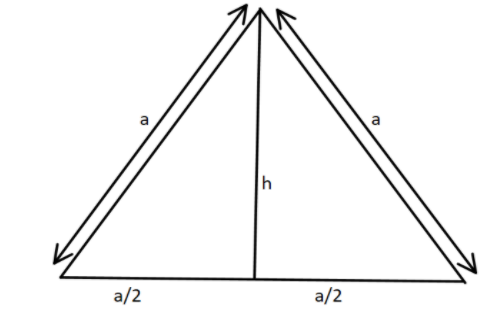
How do you find the area of an equilateral triangle without the height?
Answer
545.1k+ views
Hint: Whenever we are asked to find the area of a triangle we make use of the formula that is given by Area of the triangle $ = \dfrac{1}{2} \times base \times height$ but here the height is unknown for us. So as the triangle is an equilateral triangle we can make use of Pythagoras theorem formula that is $Hypotenuse{e^2} = Bas{e^2} + Perpendicular{r^2}$, to find the replacement of height and then by back substituting the height in the area of triangle formula we can get the required answer.
Complete step by step answer:
In the question, they have asked to find the area of an equilateral triangle without the height. So first consider the equilateral triangle as shown in the below diagram.

The above figure shows the equilateral triangle having each side equal to $a$ and height $h$.
To calculate the area of the triangle $ = \dfrac{1}{2} \times base \times height$ we need to find the height.
Now to calculate height $h$ consider the diagram as below:

The above diagram is half the side of the above equilateral triangle.
Now by using Pythagoras theorem we can find the height to find the area of the equilateral triangle.
The Pythagoras theorem is given by: $Hypotenuse{e^2} = Bas{e^2} + Perpendicular{r^2}$ here hypotenuse is $a$ , base is $\dfrac{a}{2}$ and the perpendicular is $h$ . Now substitute these in Pythagoras formula, we get
${a^2} = {\left( {\dfrac{a}{2}} \right)^2} + {h^2}$
$ \Rightarrow {h^2} = {a^2} - {\left( {\dfrac{a}{2}} \right)^2}$
$ \Rightarrow {h^2} = {a^2} - \dfrac{{{a^2}}}{4}$
$ \Rightarrow {h^2} = \dfrac{{4{a^2} - {a^2}}}{4}$
$ \Rightarrow {h^2} = \dfrac{{3{a^2}}}{4}$
Taking square root on both side, we get
$ \Rightarrow h = \dfrac{{\sqrt 3 }}{2}a$
Now, to find the area of the equilateral triangle, substitute the height $h = \dfrac{{\sqrt 3 }}{2}a$ and base as $a$ in the area of triangle formula, we get
Area of the triangle $ = \dfrac{1}{2} \times base \times height$
Area of an equilateral triangle $ = \dfrac{1}{2} \times a \times \dfrac{{\sqrt 3 }}{2}a$
Therefore, Area of an equilateral triangle $ = \dfrac{{\sqrt 3 }}{4}{a^2}$.
Note: The area of equilateral triangle can be found by using the derived formula that is Area of the equilateral triangle $ = \dfrac{{\sqrt 3 }}{4}{a^2}$ but it is not applicable to other triangles because only in the equilateral triangle we will be having all the sides are equal.
Complete step by step answer:
In the question, they have asked to find the area of an equilateral triangle without the height. So first consider the equilateral triangle as shown in the below diagram.

The above figure shows the equilateral triangle having each side equal to $a$ and height $h$.
To calculate the area of the triangle $ = \dfrac{1}{2} \times base \times height$ we need to find the height.
Now to calculate height $h$ consider the diagram as below:

The above diagram is half the side of the above equilateral triangle.
Now by using Pythagoras theorem we can find the height to find the area of the equilateral triangle.
The Pythagoras theorem is given by: $Hypotenuse{e^2} = Bas{e^2} + Perpendicular{r^2}$ here hypotenuse is $a$ , base is $\dfrac{a}{2}$ and the perpendicular is $h$ . Now substitute these in Pythagoras formula, we get
${a^2} = {\left( {\dfrac{a}{2}} \right)^2} + {h^2}$
$ \Rightarrow {h^2} = {a^2} - {\left( {\dfrac{a}{2}} \right)^2}$
$ \Rightarrow {h^2} = {a^2} - \dfrac{{{a^2}}}{4}$
$ \Rightarrow {h^2} = \dfrac{{4{a^2} - {a^2}}}{4}$
$ \Rightarrow {h^2} = \dfrac{{3{a^2}}}{4}$
Taking square root on both side, we get
$ \Rightarrow h = \dfrac{{\sqrt 3 }}{2}a$
Now, to find the area of the equilateral triangle, substitute the height $h = \dfrac{{\sqrt 3 }}{2}a$ and base as $a$ in the area of triangle formula, we get
Area of the triangle $ = \dfrac{1}{2} \times base \times height$
Area of an equilateral triangle $ = \dfrac{1}{2} \times a \times \dfrac{{\sqrt 3 }}{2}a$
Therefore, Area of an equilateral triangle $ = \dfrac{{\sqrt 3 }}{4}{a^2}$.
Note: The area of equilateral triangle can be found by using the derived formula that is Area of the equilateral triangle $ = \dfrac{{\sqrt 3 }}{4}{a^2}$ but it is not applicable to other triangles because only in the equilateral triangle we will be having all the sides are equal.
Recently Updated Pages
Master Class 9 Social Science: Engaging Questions & Answers for Success

Master Class 9 Science: Engaging Questions & Answers for Success

Master Class 9 English: Engaging Questions & Answers for Success

Master Class 9 Maths: Engaging Questions & Answers for Success

Master Class 11 Economics: Engaging Questions & Answers for Success

Master Class 11 English: Engaging Questions & Answers for Success

Trending doubts
Which places in India experience sunrise first and class 9 social science CBSE

Fill the blanks with the suitable prepositions 1 The class 9 english CBSE

Write the 6 fundamental rights of India and explain in detail

Difference Between Plant Cell and Animal Cell

What is the Full Form of ISI and RAW

Golden Revolution is related to AFood production BOil class 9 social science CBSE




